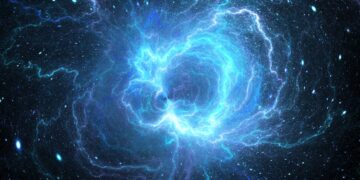The universe is a vast and enigmatic expanse, governed by fundamental forces that dictate the interactions of matter and energy. For decades, the Standard Model of physics has been the cornerstone of our understanding, describing four fundamental forces: gravity, electromagnetism, strong nuclear force, and weak nuclear force.
The Standard Model: A Masterpiece with Missing Pieces
The Standard Model has achieved monumental success, explaining the behavior of subatomic particles and the forces acting upon them. However, it accounts for only about 5% of the universe’s total matter and energy. The remaining 95% consists of dark matter (approximately 25%) and dark energy (about 70%), both of which remain elusive.
Dark matter, though invisible, is crucial for holding galaxies together, while dark energy drives the accelerating expansion of the universe. Yet, their nature and the reasons behind their proportions remain a mystery. Intriguingly, the relative abundance of these two components hints at a possible connection—a clue that some physicists believe points to the existence of a fifth force.
The Fifth Force: A Hypothetical Game-Changer
The idea of a fifth fundamental force is not new, but it has gained renewed attention as researchers explore the “dark sector” of the universe. This hypothetical force could mediate interactions between dark matter and dark energy, explaining their synchronized behavior across cosmic timescales.
Theoretical constructs like “quintessence” and “dark photons” are central to this discussion. Quintessence refers to a dynamic field that may interact with dark matter and dark energy, while dark photons are proposed particles that could serve as carriers of the fifth force. Unlike the known forces, this force would act exclusively within the dark sector, avoiding direct interactions with ordinary matter—explaining why it has remained undetected.
Observational Challenges and Evidence
Detecting a fifth force is a formidable task. Strong manifestations have already been ruled out by observations of galaxy clusters, the large-scale structure of the universe, and the behavior of neutron stars. Any remaining effects must be subtle, requiring highly sensitive instruments and vast datasets.
Cosmological observations provide a promising avenue. The distribution and evolution of dark matter halos, gravitational lensing patterns, and the cosmic microwave background may hold indirect evidence of the fifth force. These phenomena could reveal deviations from predictions made by the Standard Model, hinting at the influence of an additional force.
Why This Matters: Unifying the Dark Sector
Understanding the fifth force could revolutionize our comprehension of the universe’s dark components. If confirmed, it would provide a unifying framework for dark matter and dark energy, transforming them from isolated enigmas into interconnected phenomena. Such a breakthrough would not only refine our cosmological models but also illuminate the underlying structure of reality.
Moreover, the implications extend beyond cosmology. A fifth force could influence particle physics, shedding light on the limitations of the Standard Model and guiding the development of new theories. It may even provide insights into the early universe, revealing how dark matter and dark energy shaped its evolution.
The Path Forward: Tools and Techniques
Advancing our understanding of the fifth force will require cutting-edge technology and collaborative efforts. Observatories like the James Webb Space Telescope (JWST) and ground-based facilities such as the Vera C. Rubin Observatory are poised to provide critical data. Their ability to capture detailed images of distant galaxies and measure the distribution of dark matter will be invaluable.
Simultaneously, experiments in particle physics could offer complementary insights. High-energy collisions at the Large Hadron Collider (LHC) may reveal hints of dark sector interactions, while precision measurements of atomic and molecular systems could detect tiny deviations caused by a fifth force.
A Future of Discovery
The search for a fifth force is not just a quest for answers; it is a journey toward a deeper understanding of the universe and our place within it. It challenges our perceptions of reality, urging us to look beyond the visible and explore the hidden dimensions of existence.
As scientists continue to probe the dark sector, they are rewriting the story of the cosmos, piece by piece. The potential discovery of a fifth force represents a new chapter—one that could redefine the boundaries of human knowledge and inspire generations to come.
Conclusion
The universe is a tapestry of mysteries, woven with threads of light and shadow. While the Standard Model has unraveled many of its secrets, the dark sector remains an enigma, hinting at forces and interactions beyond our current understanding. The possibility of a fifth fundamental force offers a beacon of hope, promising to illuminate the dark corners of the cosmos and reveal the intricate dance of matter and energy.



















